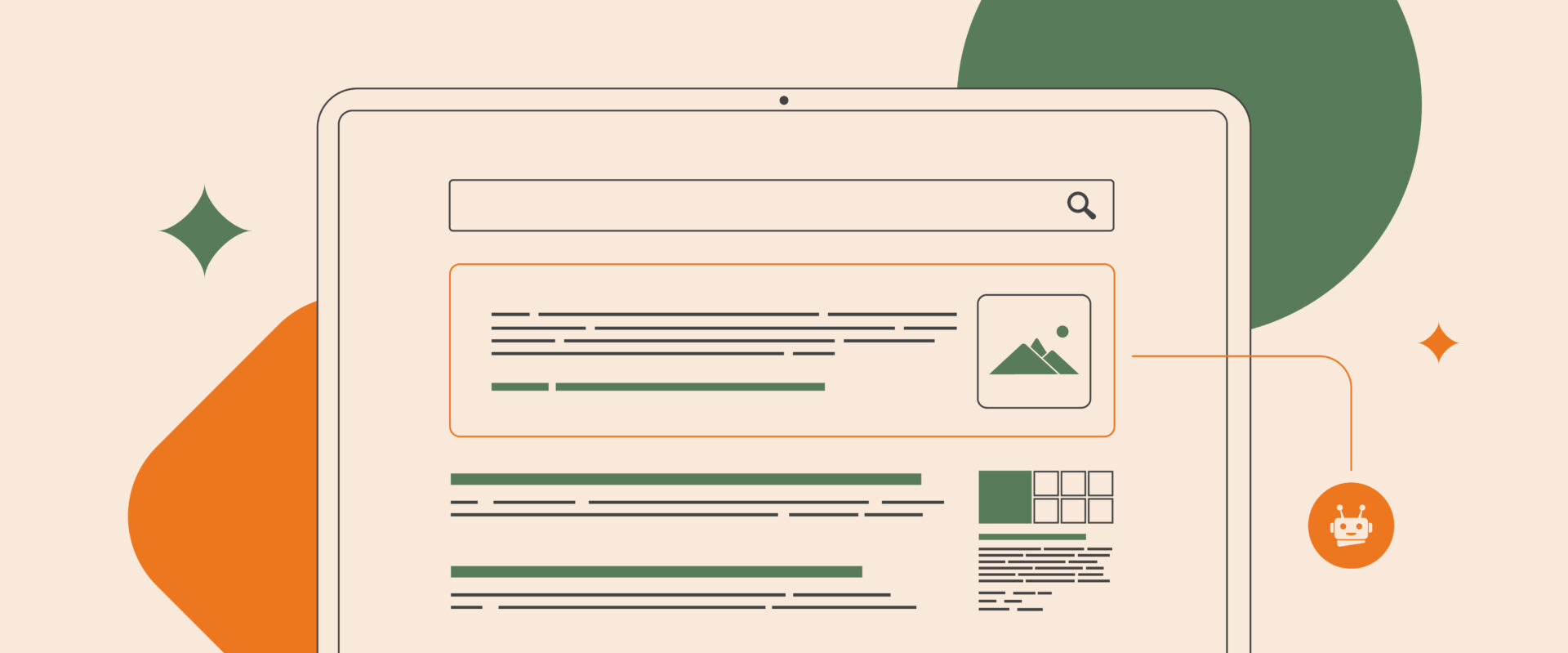
TLDR: There’s still a lot of uncertainty about the impact AI search features like AI Overview and Copilot will have on websites’ SEO performance. We can confirm that a solid, human-first, conversational tone with content that answers real-world questions about your products and services remains the best way to stay visible on search engines and engage with your audiences.
In our last article, we introduced Google’s AI Overview search feature and discussed how the technology behind it represents a dramatic shift in the way search engines present users with search results.
At the moment, the introduction of AI Overviews is still relatively recent, so there’s still much work to be done in determining exactly how this change in the way search engines work will impact the amount of traffic that searches drive to individual websites. Some studies say that AIOs drive more traffic, while others say less. Regardless of which ends up being the case, the introduction of AI means we’re in the middle of a period of search volatility that’s likely to continue for some time.
This week, we’ll look at some of the potential impacts of the AIO rollout and what the shift to AI search might mean for your business.
This article is the second in a series of three articles about the ongoing introduction of generative AI into the world of search:
- What Is AI Search? (And Other FAQs
- What Does the Shift to AI Search Mean For Your Business? <- You Are Here
- How is M&R Adapting to the Switch to AI Search?
You May Well See a Decrease in Organic Traffic… Or an Increase. Or You May Hold Steady.
AIOs have only been a part of the general public’s search landscape for a few months so far, so the results from the dozens or hundreds of studies regarding AI’s impact on organic traffic are all over the place.
Some experts report that sites they track are seeing decreases in organic traffic of 9% or more. Some are reporting small increases in organic traffic. Nearly all of them are hampered by small sample sizes, samples limited to only one or two verticals, or data that’s skewed by the inclusion of data from the initial beta testing of AI Overview, then known as Search Generative Experience.
All that by way of saying, we are still – as an industry – trying to determine precisely how AIOs impact a site’s organic traffic.
There are a few reasons to assume organic traffic will go down and a few reasons to think it will go up.
Why AI Might Harm Organic Traffic
AI Overviews Provide Complete Answers
Imagine performing a search for a question: What colors are available for the new Nike Air Force Ones?
Before AI Overview, the search engine results page (SERP) for that query would likely have included:
- Google Shopping ads for Nike AF1s
- Reviews for Nike AF1s
- A Local Pack featuring nearby stores that sell Nike sneakers
And highly visible on the page would have been a link to Nike’s website, probably with a “site links” sub-entry with a direct link to the company’s Air Force Ones shopping page.
Now, that same search is likely to trigger an AI Overview that answers the user’s question, directly on the SERP. While there will be small links to the AI’s sources for its information, these are dwarfed by the content that surrounds them. Nonetheless, earning a spot within these “AI sources” links is the best way to gain traction with AI Overviews.
Fortunately, M&R’s Copy team has already developed and implemented SEO tactics that are helping our clients be considered reliable sources for Google’s AI algorithm. A number of M&R-supplied SEO articles are appearing in the #1 or #2 positions in the AI sources for multiple queries.
AI Overviews Take Up a Lot of Real Estate
AI Overviews are huge. We don’t mean they’re popular; we mean they literally take up a ridiculous amount of space on the SERP. In the example above, the actual organic link to Nike’s sales site will still remain high in the organic listings, but the large AI overview feature will push all of those listings much lower on the page, possibly below the fold.
The lower page position will make it less likely for users ever to see the direct link to your site, much less follow it.
Why AI Might Help Organic Traffic
AI Overviews Significantly Limit Click Competition on the SERP
Thanks to the way the AIO changes a SERP’s layout, there’s actually a potential for increased traffic from an AIO:
- The AIO pack is huge and displaces organic results and other SERP features way down the page
- The AIO pack only has three visible links but takes up more screen than other SERP features that feature more links
- If you’re one of the lucky three pages chosen for inclusion in the AIO source cards, then you’re one of only a handful of links on screen, as opposed to being one of a dozen or more.
AI Overviews Can’t Completely Answer Many Questions
AIOs have gotten very good at answering many types of questions and will continue to improve over time. Still, there are many situations where AI can provide a general answer or a partial answer but can’t offer a complete, actionable answer to a user’s query. Examples are questions that require highly technical answers, questions that involve evaluating opinions, or questions asking for personal recommendations:
- What kind of drill bit should I use to drill through ¼” sheet aluminum?
- Who makes the best cast-iron Dutch oven?
- What type of sports coat is best for my body shape?
For all of those searches, Google could return an AIO, but the likelihood of that AIO returning all of the information the user is looking for is pretty low:
- The AIO will likely provide information on metal drilling in general but will likely not get into the details of working with different alloys of aluminum, how different drill speeds require different bits, etc.
- The AIO can give details of which products have the highest ratings, which have more positive sentiment in their reviews, and which are getting the most buzz. Still, the user will likely want considerably more detail on a few different models before they make a decision.
- The AIO can only provide general information about pairing clothing with specific body types. The user will need to read one or more specific articles to learn how each writer classifies different body types and what clothing styles work.
In each of these cases, the pages that appear in the three source cards in the AIO are likely to be visited as the user seeks additional details.
Other AI Implications to Be Aware Of
The AI Is Still Learning, and Google Is Still Tweaking
There’s still a lot of uncertainty in the world of AI, and part of that uncertainty is due to Google actively tuning and improving its AI models every day. Considering that a lot of the remaining uncertainty comes from the unpredictability inherent in generative AI systems, just the evolution of the platform is making it more difficult than usual to make accurate predictions as to how well a piece of content will be ranked.
In our next article discussing AI search, we’ll get into some of the things we’re doing at M&R to keep tabs on the AI search situation and tactics we’re using to help improve our clients’ SEO performance in light of this emerging technology.
AI Overviews Will Have a Long Acceptance Curve
AI is still far from perfect. Generative AI responses from search queries are still subject to misinformation, hallucinations (an insider term referring to AI’s occasional tendency to “make up” information where it perceives a gap in the online knowledge base), and even taking jokes too seriously.
For instance, a sarcastic post on X about adding Elmer’s Glue to pizza sauce to keep the cheese from sliding off became infamous when a Google AI Overview recommended Elmer’s Glue to users requesting actual pizza sauce recipes.
As a result, it will take some time for some members of your audience to trust AI information. Therefore, you should continue to see plenty of work being done on our end to ensure that your site continues to rank well in organic search and AI search.
The AI Shift Has Introduced Severe Volatility to the Search Landscape
At the moment, the entire search landscape is experiencing high volatility, meaning that sites can be highly ranked for a keyword on one day and completely unranked for it the next, or vice versa. This volatility is largely due to the continuing development of AI Overview technology and the changes that algorithms are imposing on SERPs.
On a scale of 1-10, with 10 being the most volatile, at the time of this writing, SEO company Semrush puts the current state of search volatility at 9.3, so businesses should expect to see shifts in their SEO performance – both up and down – over the coming months.
At the moment, many of our clients are seeing dramatic improvements, a few are seeing minor performance declines, but this volatility will eventually settle down. (Probably just in time for the next big shakeup!)
It’s Okay: We’re Keeping an Eye on Things
Yes, SEO is a little chaotic right now, but we live for that kind of thing. When new things come along, we’re ready to help your business adjust to a changing world. The launch of AI search is an exciting development, and we’re proud to be helping our clients successfully navigate the most significant change in search in the past several years. From staying on top of the latest news from the field to performing our small-scale research and analysis, the team at M&R Marketing is keeping our eyes on AI.
Call to learn more about how M&R is facing the rise of AI search: 478-621-4491
More About AI Search:
- What Is AI Search? (And Other FAQs)
- How is M&R Adapting to the Switch to AI Search?
Detailed Marketing Deets
Want some profound insight into all things marketing? Check out our Definitive Guide Series for detailed information, tips, and advice regarding:

